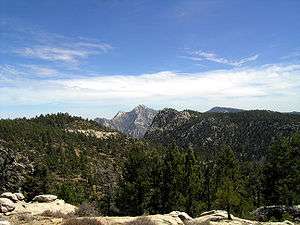Peninsular Ranges
| Peninsular Ranges | |
|---|---|
 | |
| Highest point | |
| Peak | San Jacinto Peak |
| Elevation | 10,834 ft (3,302 m) |
| Geography | |
| Countries | Mexico and United States |
| States | Baja California Sur, Baja California and California |
| Geology | |
| Age of rock | Mesozoic |
| Type of rock | Granite |
The Peninsular Ranges (also called the Lower California province[1]) are a group of mountain ranges, in the Pacific Coast Ranges, which stretch 1,500 km (930 mi) from southern California in the United States to the southern tip of Mexico's Baja California Peninsula; they are part of the North American Coast Ranges that run along the Pacific coast from Alaska to Mexico. Elevations range from 500 to 10,834 feet (152 to 3,302 m).
Geography
The Peninsular Ranges include the Santa Ana Mountains, Temescal and other mountains and ranges of the Perris Block, San Jacinto and Laguna ranges of southern California continuing from north to south with the Sierra de Juarez, Sierra San Pedro Mártir, Sierra de San Borja. Sierra San Francisco, Sierra de la Giganta, and Sierra de la Laguna in Baja California. Palomar Mountain, home to Palomar Observatory, is in the Peninsular Ranges in San Diego County, as is Viejas Mountain. The Peninsular ranges run predominantly north-south, unlike the Transverse Ranges to their north, which mostly run east-west.
Geology
Rocks in the ranges are dominated by Mesozoic granitic rocks, derived from the same massive batholith which forms the core of the Sierra Nevada Mountains in California. They are part of a geologic province known as the Salinian Block which broke off the North American Plate as the San Andreas Fault and Gulf of California came into being.
Between this set of ranges and the Transverse Ranges is the complex Malibu Coast—Santa Monica—Hollywood fault, which exists as the border between these two mostly geologically unitary provinces.[2]
Ecology and flora
Nearctic
Most of the Peninsular Ranges are in the Nearctic ecozone. Several terrestrial ecoregions cover portions of the Peninsular Ranges. On western-coast side of the northern portion of the ranges the California montane chaparral and woodlands sub-ecoregion of the California chaparral and woodlands ecoregion covers in southern California and northern Baja California. On western-coast side of the southern portion of the ranges the Baja California desert ecoregion covers in the southern portion of the Peninsular Ranges in Baja California and Baja California Sur. On eastern side of northern ranges, the Sonoran Desert ecoregion covers southeastern California and northeastern Baja California as far south as the town of Loreto, Baja California Sur. On the eastern side of the Laguna Mountains in San Diego County the Anza-Borrego Desert State Park is known for its springtime profusion of Colorado Desert (Sonoran) wildflowers. On eastern-Gulf of California side of the southern portion of the ranges the Gulf of California xeric scrub ecoregion covers the range in Baja California Sur.
The higher portions of the Peninsular Ranges, especially the west-facing slopes, are home to coniferous and mixed evergreen forests. Cleveland National Forest covers much of the higher Southern California Peninsular Ranges. The vegetation includes oak woodlands and forests of Jeffrey Pine (Pinus jeffreyi) and Coulter Pine (Pinus coulteri). The Sierra Juarez and San Pedro Martir pine-oak forests cover upper slopes of Sierra Juarez and San Pedro Martir ranges in Baja California. These isolated forests, predominantly Tamarack Pine (Pinus contorta subsp. murrayana), Sugar Pine (Pinus lambertiana), Parry Pinyon (Pinus quadrifolia), White Fir (Abies concolor), California Incense Cedar (Calocedrus decurrens), and junipers. Oak species include Coast Live Oak (Quercus agrifolia), Engelmann Oak (Quercus engelmannii), Canyon Live Oak (Quercus chrysolepis), and Baja Oak (Quercus peninsularis). These higher portions of the Peninsular Ranges harbor many rare and endemic species.
Neotropic
Southern Baja California Sur is part of the Neotropic ecozone. The southern end of the Baja California Peninsula, including the Sierra de la Laguna Peninsular Range, was formerly an island, and evolved in relative isolation from the northern part of the peninsula and ranges. Its flora and fauna share many affinities with southern Mexico and Central America. It includes three distinct ecoregions, the Sierra de la Laguna dry forests, Sierra de la Laguna pine-oak forests, and San Lucan xeric scrub.
See also
- Peninsular Ranges index
- Transverse Ranges
- List of mountain ranges
References
- ↑ Benke, Arthur C.; Cushing, Colbert E. (2005). Rivers of North America. Academic Press. p. 543. ISBN 0-12-088253-1.
- ↑ Meigs, Andrew J.; Oskin, Michael E. (2002). "Convergence, block rotation, and structural interference across the Peninsular-Transverse Ranges boundary, eastern Santa Monica Mountains, California". In Barth, Andrew. Contributions to Crustal Evolution of the Southwestern United States. Geological Society of America. pp. 281–7. ISBN 978-0-8137-2365-5.
| Wikimedia Commons has media related to Peninsular Ranges. |
External links
Coordinates: 29°57′00″N 114°43′01″W / 29.95°N 114.717°W